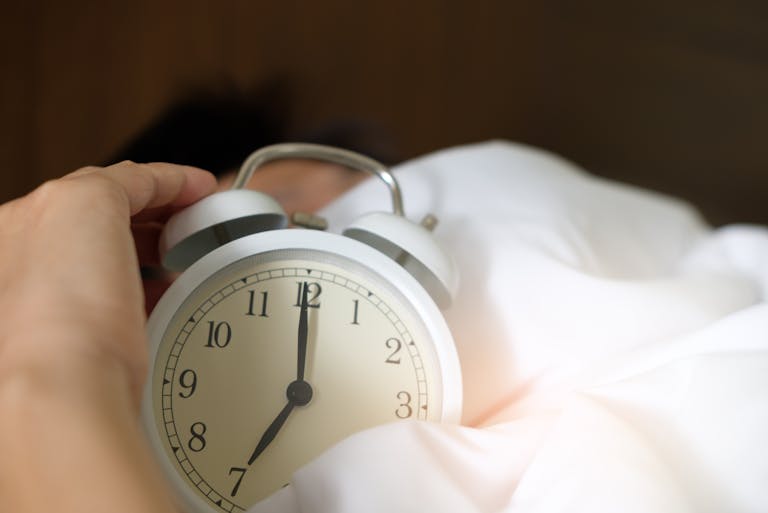Sleeping with headphones has become common, whether to drown out urban noise, create a cocoon of relaxation with music, or indulge in sleepcasts. However, a critical question arises: Is it safe to sleep with earphones?
Today, sleep is often sought as a refuge from the hustle and bustle of daily life. Individuals frequently turn to various strategies to enhance their sleep experience. Among these strategies, the use of earphones or earbuds has gained popularity.
Is it Safe to Sleep with Earphones? No!
So, Is it safe to sleep with earphones? While the temptation to drift off into a world of soothing sounds is understandable, sleeping with earphones has drawbacks. There are compelling health reasons why this practice is not recommended, particularly for extended periods.
Prolonged use of earphones, especially overnight, can push earwax deeper into the ear canal. This, in turn, results in an uncomfortable buildup of earwax, which can cause discomfort, potentially impact hearing, and create a sensation of fullness when in motion.
What does the Research Show?
A study published in Noise and Health sought to investigate self-reported hearing and portable music listening habits in adolescents. Its findings provided noteworthy insight into the potential risks associated with using earphones, especially during sleep.
While most participants listened at moderate sound levels for shorter durations, a subgroup (10%) exposed themselves to sound levels between 90 and 100 dB for extended periods, even during sleep.
The study suggests that individuals in this subgroup might be at risk of developing future noise-induced hearing impairments. Now you know the answer – Is it safe to sleep with earphones?
If You Still Want to Wear Headphones or Earbuds During Sleep…
Certain precautions can be taken to minimize potential risks for those adamant about wearing headphones or earbuds during sleep.
1. Avoid Noise-Cancelling Features
While noise-canceling headphones enhance the auditory experience by blocking external sounds, they pose safety concerns during sleep. In emergencies, the inability to hear external sounds, such as calls or alarms, can jeopardize personal safety.
Therefore, it is advisable to avoid noise-canceling features, ensuring one remains alert to one’s surroundings, especially during sleep when responsiveness to alarms is crucial.
2. Don’t Use Corded Models
Corded earbuds or headphones present a safety threat due to the risk of entanglement. Tangled cords may inadvertently increase the volume or, in extreme cases, pose a strangulation hazard.
Opting for wireless models eliminates this risk, providing a safer alternative for sleep. The freedom of movement without the constraints of cords enhances safety and contributes to a more comfortable sleep experience.
3. Keep the Volume Low
Maintaining a low volume is crucial for mitigating potential hearing damage. If headphones or earbuds are worn for an extended period, the volume should be around half the maximum or lower.
A useful guideline is that if someone standing within arm’s reach or lying next to you can hear the music, the volume is too high. Consistently exposing your ears to high volumes, especially during sleep, can lead to gradual hearing loss over time.
While the allure of falling asleep to music or calming sounds is understandable, it is essential to weigh the potential risks associated with sleeping with earphones. Accumulated earwax, potential hearing impairments, and safety concerns underscore the importance of cautious headphone use, especially during sleep.
4. Try an External Speaker Instead
An alternative approach for those who sleep alone or have an understanding partner is using an external speaker. For instance, placing a speaker at a reasonable distance during a holiday sale allows for a shared auditory experience without the discomfort or potential risks of wearing earphones.
This method also alleviates pressure on the ears, reducing the likelihood of discomfort. Choosing an external speaker with a timer or automatic shut-off feature ensures that the sound is not continuously playing throughout the night, balancing auditory enjoyment and safe listening practices.
If the practice is unavoidable, adopting safety measures such as avoiding noise-canceling features, opting for wireless models, keeping the volume low, and considering external speakers can contribute to a safer auditory experience.
Final Words
In conclusion, prioritizing both the enjoyment of audio content and preserving hearing health is crucial. As technology continues to evolve, staying informed about best practices to balance enjoying the benefits of audio experiences and safeguarding one’s well-being, particularly in sleep and relaxation, is essential. I hope you know now. Is it safe to sleep with earphones?
Some of the links in this post are affiliate links. This means if you click a link and make a purchase we will receive an affiliate commission at no extra cost to you.
